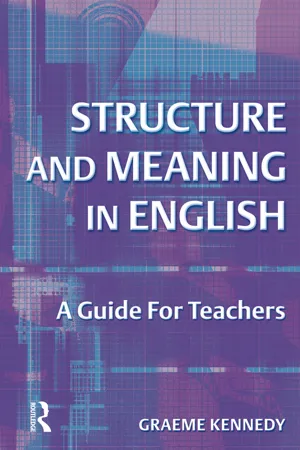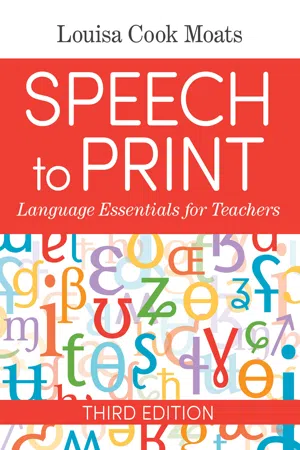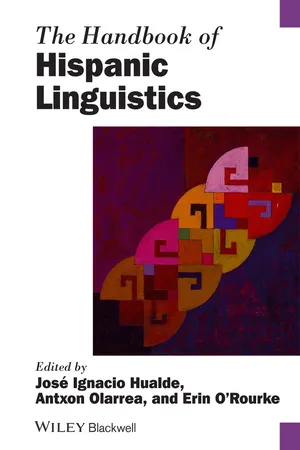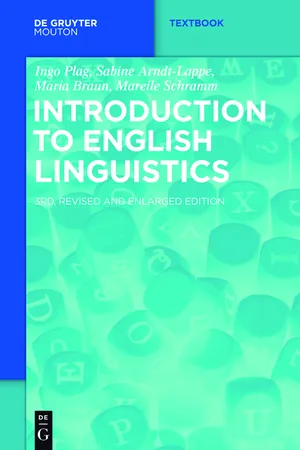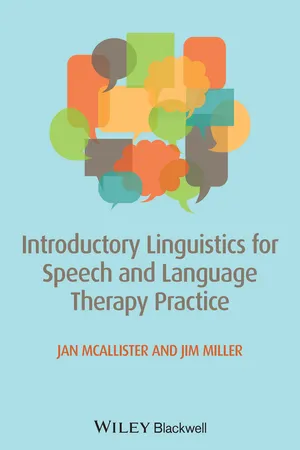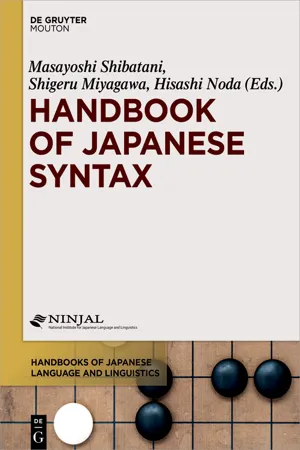Languages & Linguistics
Simple Sentence
A simple sentence is a grammatical structure that consists of just one independent clause, typically containing a subject and a predicate. It expresses a complete thought and stands alone as a complete sentence. Simple sentences are fundamental to language and are often used to convey clear and concise information.
Written by Perlego with AI-assistance
Related key terms
10 Key excerpts on "Simple Sentence"
- eBook - ePub
Structure and Meaning in English
A Guide for Teachers
- Graeme Kennedy(Author)
- 2014(Publication Date)
- Routledge(Publisher)
Chapter 2 the word classes (nouns, verbs, etc.) were mentioned. In language use, words are grouped together in grammatical structures to express meaning. A sentence is one such unit of linguistic description. Most fluent speakers of a language have a sense of the ‘unity’ and ‘completeness’ of what is said or written and can identify when a string of words is not ‘well formed’ or ‘grammatical’. For this reason it has sometimes been said that sentences have a psychological as well as a grammatical reality.For example, in the following examples most people would agree that 1 has a sense of completeness while 2–5 seem incomplete. Sentence 2 has no subject (we don’t know who has dinner). While 3, 4 and 5 have a subject, the rest (the predicate) seems incomplete. (* Shows structures that are not grammatical.)1 I have dinner about 7 o’clock most nights.2 *have dinner about 7 o’clock most nights.3 *I have about 7 o’clock most nights.4 *I have dinner 7 o’clock most nights.5 *I have dinner about 7 o’clock most.Sentences normally have at least a subject and a verb (but not always, especially when we speak). A Simple Sentence consists of a single clause containing one verb phrase. It can be joined to other clauses by means of conjunctions to make complex sentences. These are described in Chapter 7 .Before looking more closely at the parts of Simple Sentences, we need to be aware that in spoken English conversation, which is by far the most typical or frequent use of the language, the concept of ‘sentence’ is often rather different from that which is considered appropriate in written English. When we speak, our ideas usually flow in such a way that, in addition to saying what we intend, we also make false starts, change direction, leave things unfinished, and so on. When we speak, our utterances - David Hornsby(Author)
- 2014(Publication Date)
- Teach Yourself(Publisher)
Chapter 8 ). For linguists, syntax means the study of the set of rules governing the way that morphemes, words, clauses and phrases are used to form sentences in any given language.Subjects and predicatesHowever, the distinction between ‘word-level’ and ‘sentence-level’ grammar is far from watertight, and there is a considerable grey area between the two. Linguists sometimes refer to morphosyntax when describing phenomena which straddle both levels: grammatical gender, for example, often manifests itself at word level in inflection, but may also affect relations between items within a sentence in the case of the syntactic phenomenon of agreement (or concord).Calling syntax ‘the grammar of sentences’ is all very well, but sentences prove as difficult to define as ‘words’ did in the previous chapter. We are used, in literate societies with a written-language bias, to thinking of a sentence as something that generally begins with a capital letter and ends with a full stop, but this does not get us very far. A traditional definition of a sentence as ‘the expression of a complete thought’ is not helpful either: are elderberry wine, exactly or good! not ‘complete thoughts’? In traditional grammar, sentences were required to have a subject and a predicate, i.e. something we are talking about (the subject) and then something said about it (the predicate):1 Dinosaurs existed.2 Samantha is preparing for her bar examinations.3 Paul gave a tip to the waiter.Identifying the subject in Latin, Russian or Polish would be straightforward, because the nouns would be case-marked, i.e. inflected according to their function in the sentence. This is no longer true of English (though it used to be), but pronouns – with the exception of third-person singular it – do retain case-marked forms, so we can apply a substitution test. Thus in the list above, the subjects are Dinosaurs, Samantha and Paul, because they alone can be replaced by subject (or nominative) forms (they, she and he- eBook - ePub
Speech to Print
Language Essentials for Teachers
- Louisa Cook Moats(Author)
- 2020(Publication Date)
- Brookes Publishing(Publisher)
natural grammatical knowledge. It is learned from exposure to language and requires little formal instruction. It does not depend on having heard any particular sentence before and does not depend on the speaker’s knowledge of specific word meanings. It does depend on the speaker having heard many sentences that are formed within the grammatical rule, and the speaker’s ability to assimilate the underlying structures from exposure. Remarkably, most human infants begin that learning process before they are a year old, as long as caregivers communicate verbally with them.To summarize, the following truths are evidence that syntactic rules and frameworks are part of what the speaker of a language knows, and that this language system has unique properties. •The existence of syntactically correct nonsense indicates that the syntactic rule structure exists apart from the meaning of the words it might contain. •Truth or meaning can be expressed in sentences that are considered to be grammatically incorrect.•The order and grouping of words within a language system allows us to understand relationships among the ideas, such as subject–verb–object relationships, or to answer basic questions such as Who did what to whom? How? When? Why? Where?•Sentences may be ambiguous—they can be interpreted in two or more ways. •Sentences with different word sequences can mean the same thing. •Words can be combined in an infinite number of ways within the syntactic frames or rules of a language. WHAT IS A SENTENCE?A sentence (S) is generally defined as an underlying syntactic scaffolding with two required slots that tell a simple story: Something or someone is/was/does/did something to something or someone else. What is the nature of the slots in this narrative scaffolding? Each structural slot holds categories of words, phrases, or clauses that play required roles of the doer or topic, the doing or happening, and (often) the done to. The doer or topic—the thing, idea, or person that the sentence is about—is its subject. The action or being slot of the sentence is its predicate; - eBook - ePub
- José Ignacio Hualde, Antxon Olarrea, Erin O'Rourke, José Ignacio Hualde, Antxon Olarrea, Erin O'Rourke(Authors)
- 2012(Publication Date)
- Wiley-Blackwell(Publisher)
20
The Simple Sentence
HÉCTOR CAMPOS1 Introduction
A “sentence” (Sp. oración ) is a minimal unit of predication that relates a subject and a predicate, where the former will be typically represented as a noun phrase (NP) and the latter as a verb phrase (VP). Traditionally, sentences have been classified according to three criteria:(1) a. according to their dependence upon or independence from other units b. according to the nature of their predicate c. according to the “attitude” of the speakerCriterion (1a) distinguishes main from embedded clauses. Whether a sentence appears in a main or in a subordinate clause is relevant for the application of certain syntactic operations; however, this is too general a criterion to help us understand – and let alone classify – the variety of sentences that exist in a particular language. Criterion (1b) classifies sentences according to the nature of the verb; that is, whether it is transitive, intransitive, copular, passive, reflexive, reciprocal, or impersonal (see Gili Gaya 1961: s. 32; GLE: ch. 19). However, as noted in the NGDLE, these particular properties of verbs, while relevant for certain aspects of syntactic analysis, do not necessarily constitute “sentential types” and “do not constitute grammatical properties that will necessarily help define a sentential paradigm” (NGDLE: s. 1.13k).Criterion (1c) is the one that proves most fruitful to classify sentences and it is the one that we will pursue in this chapter. I will be following the classification proposed by the Real Academia Española (RAE) in the NGDLE (2009) and NDGLEM (2010), which revise that of previous editions of the grammar (GLE 1931; ESB 1979; NGDLE 2009), and which incorporates terminology and concepts of modern linguistics). I will be framing the new classification proposed by the RAE on more recent theories of syntax, semantics, and pragmatics. Section 2 introduces the theoretical framework that I will be using throughout this chapter. Sections 3 and 4 propose a classification based on this framework. - eBook - ePub
Webster's English Language Companion
English language guidance and communicating in English (US English)
- Betty Kirkpatrick(Author)
- 2015(Publication Date)
- Geddes and Grosset(Publisher)
GRAMMAR
The Sentence and the Paragraph
THE SENTENCE
The most important unit of structure is the sentence . Most of the other grammatical units are parts that go together to form a sentence. However, that leaves us with the question “What is a sentence?” and there has been some dispute about the definition. The traditional view of the sentence seems as good a jumping-off point as any from which to look at the sentence: a unit of language that can stand alone and make sense.The following are all complete in themselves, make sense and are, therefore, all sentences: We ran. The boy kicked the ball. They played hard and they won. Look over there!Minor sentences
The following examples are also all complete in themselves and make sense and are, therefore, sentences. They are known as minor sentences or irregular sentences .They are called minor sentences because they lack some of the other usual grammatical features of a sentence. For example, a minor sentence often lacks a subject and a predicate (see here ). Minor sentences are most common in spoken English and in conversation in literary fiction. They are also common in certain kinds of written English such as notices, labels and adverts. The following are examples of minor sentences:No! Nonsense! How terrible! What a view! Good try! Taxi! No entry. Well done! Once bitten, twice shy.Major sentences
Other sentences are known as major sentences or regular sentences . A major sentence usually has a subject and predicate (see below). The following are examples of major sentences :We ran. The boy kicked the ball. Mother baked a cake. She leaves tomorrow. They are coming to town. She studied hard, but she failed the exam. I called him when I arrived.Subject and predicate
Basically, a sentence is a combination of two grammatical units—the subject and the predicate .SubjectThe subject of a sentence refers to what the sentence is about, often the person or thing that carries out the action of the verb. The subject usually gives a clear idea about what the sentence is about. The subject - eBook - ePub
Exploring the Spanish Language
An Introduction to its Structures and Varieties
- Christopher Pountain(Author)
- 2016(Publication Date)
- Routledge(Publisher)
4Spanish sentences and their structure
In this chapter we are going to look at some features of Spanish syntax, or sentence structure. Spanish syntax is on the whole very well described in the large reference grammars of Spanish, and it would be superfluous and inappropriate to try and condense such compendious material into a few pages in this book. The intention here is therefore to give a slightly different slant to the description of Spanish syntax by concentrating on a number of issues which may set you thinking further:● What do we mean by a ‘sentence’?● How many different sentence types are there?● Why do sentences contain different types of constituent?● What is the relation between syntactic functions and meaning?● Do different registers of Spanish (see Chapter 7 ) have different syntaxes?4.1 What is a sentence?
The notion of a sentence (frase or, more formally, oración in Spanish), like that of a word, is notoriously elusive, and it is probably not possible to give any linguistically rigorous definition of the term. Within traditional grammar, however, we find two kinds of definition, both essentially arbitrary, which have won wide acceptance in normative and pedagogical circles. One is semantic in nature, and usually runs along the lines that a sentence expresses a ‘complete thought’. A typical example is the following:La intención del hablante divide la locución en unidades de sentido completo en sí mismas llamadas oraciones (Esbozo 1973: 349; my underlining)It is difficult to envisage any rigorous notion of what might constitute a ‘complete thought’; in practice, it probably amounts to much the same thing as the usual syntactically-based definition, which characterises a sentence as a structure which has a ‘subject’ and a ‘predicate - eBook - ePub
- Ingo Plag, Sabine Arndt-Lappe, Maria Braun, Mareile Schramm(Authors)
- 2015(Publication Date)
- De Gruyter Mouton(Publisher)
The above rules can be read as ‘a sentence consists of an NP and a VP, an NP consists of a determiner, an adjective phrase, a noun and a prepositional phrase, a prepositional phrase consists of a preposition and a noun phrase’, and so on. And if we then have a list of words marked as nouns, adjectives, determiners, etc., we can use the phrase structure rules to generate grammatical English sentences.The rules in (34) neglect, however, an important aspect of sentence structure that we have not touched upon yet. This aspect concerns the possibility to have sentences inside sentences. (35) lists some structures of this kind. Such sentences inside other sentences are called subordinate clauses .(35) a. Helen knew [that her husband was ill]. b. [That Anthony loves his teacher] is obvious to anyone. c. He moved to Boston [because his girl-friend lives there]. d. I showed her the guy [who will build the house]. These subordinate clauses are constituents similar to the phrases discussed above. For example, they often can be substituted by a pronoun, as inHelen knew it. Their internal structure, however, seems to be different from that of phrases. Technically, we call such a structure a clause , which is a syntactic unit that consists minimally of a verb phrase and its s ubject. Sentences are defined as the largest syntactic units and they are made up of one or more clauses. In a Simple Sentence there is only one clause, while complex sentences contain at least one subordinate clause. The sentences in (35) are complex sentences, consisting of two clauses, a superordinate clause (often called matrix clause ) and a subordinate clause. A term that is potentially competing with ‘matrix clause’ is main clause , which refers to clauses that can stand on their own.Obviously, the existence of subordinate clauses considerably complicates our analysis of the syntax of English, and, needless to say, it is still quite a long way to go from our little phrase structure grammar in (34) to a full and adequate description of English syntax. Nevertheless, it should have become clear on which methodological principles such a grammar could be built. - eBook - ePub
Analysing Sentences
An Introduction to English Syntax
- Noel Burton-Roberts(Author)
- 2021(Publication Date)
- Routledge(Publisher)
11 Languages, sentences and grammarsDOI: 10.4324/9781003118916-12This final chapter is concerned with the general background to the kind of analysis presented in this book and suggests, in the light of some history of linguistic analysis, how you might further develop your study of the English language.Languages
I’ll begin by considering a general question:A natural answer often given is[1] What is a language?[2] A language is a system of communication.This seems reasonable enough, but it doesn’t give us a clue as to how to go about analysing a language. In asking the question, I want to raise certain questions about the kind of analysis presented in this book, and to put it in context. To do this, I’ll consider the following answer:[3] A language is a set of sentences.Perhaps you feel this is a dry and unappealing answer to our question, one that fails to do justice to the wonder of language. I hope to show that this answer – when its implications are explored – does do justice to the wonder of language. It was Noam Chomsky (Professor of Linguistics at The Massachusetts Institute of Technology) who early in his career (in the 1950s) suggested that thinking of a language as a set of sentences opened up a fruitful way of thinking about the nature of language. Taken out of context, it probably makes little sense. But answers like that are just beginnings. We have to ask what its implications are for how languages are to be described, what further questions it raises. In fact, the further questions raised by [3] have had a profound effect on the development of language study over the last seventy years or so.If a language really is a set of sentences, it follows that different languages are distinguished by being made up of different sets of sentences. Two people will speak exactly the same language only if the sets of sentences in each of their languages are exactly the same. A consequence of this is that, almost certainly, no two people speak exactly the same language. - Jan McAllister, James E. Miller(Authors)
- 2013(Publication Date)
- Wiley-Blackwell(Publisher)
Before you embark on this chapter, it would be advisable to check that you have understood the material in Chapter 5, Parts of Speech, and Chapter 6, Word Structure. In Chapter 5, we were able to give only a preliminary account of parts of speech, because a full account depends on an understanding of sentence structure, which we will begin to address here. But you will need to have a basic grasp of parts of speech if you are to be able to understand what we say here. In Chapter 6, you should review the material about inflectional suffixes, because there is a close relationship between sentence structure and inflectional morphology.As we noted in Chapter 1, the level of linguistic description that is concerned with sentence structure is called syntax. Syntax (from Classical Greek sun ‘with, together’ and taksis ‘placing’) is the study of phrases and clauses, and the key concept, a very traditional one, is that of construction – something that is ‘built together’ out of different pieces. When we examine constructions, we pay attention to the kinds of bits that combine to build them, the order in which the bits are arranged and the links between the bits – between words in phrases, between phrases in clauses and between clauses in sentences. These basic structural relationships will be our focus in this chapter. In later chapters, we will extend these fundamental concepts to explain how more complex syntactic structures are formed and how these are used communicatively.7.1 Why do SLTs need this knowledge?A client who could not use syntax would only be able to produce absurdly limited messages. Contrast the child who can produce the isolated words pictures and book with the child who can say the pictures in the green book or Show me the pictures in the green book or even not the green book, the blue book – with the Gruffalo- eBook - ePub
- Masayoshi Shibatani, Shigeru Miyagawa, Hisashi Noda, Masayoshi Shibatani, Shigeru Miyagawa, Hisashi Noda(Authors)
- 2017(Publication Date)
- De Gruyter Mouton(Publisher)
Yoshio Nitta1Basic sentence structure and grammatical categories
1Introduction
Not only in Japanese but probably in most languages, from the point of view of the elements comprising the core of sentence formation, sentences can be divided into two types: free-standing word sentences and predicate sentences. Predicate sentences can be further subdivided into several subtypes, depending on one’s point of view. In terms of the parts of speech comprising the predicate, sentences can be divided into verbal sentences, adjectival sentences, and nominal sentences; in terms of the events described by the sentence, they can be divided into action sentences, stative sentences, and attributive sentences; in terms of the speech-communicative function played by the sentence, they can be divided into declarative, interrogative, imperative, and purposive.The type of the sentence affects its internal structure, and affects the types of grammatical categories that can appear in a sentence and how the grammatical meaning associated with the grammatical categories is realized. The type of text that forms the context in which a sentence appears also affects the type of sentence that can appear and the grammatical categories that can appear in the sentence. One such text type difference is the difference between a conversation in which there exists a hearer and a monologue in which there does not. This difference in type affects the type of sentence and the grammatical categories that may appear.2Free-standing word sentences
A predicate sentence is composed of the predicate that forms its core and some number of elements subordinate to it. Predicate sentences have a varied internal structure and an assortment of grammatical categories may appear. This chapter outlines the basic internal structures of predicate sentences and the grammatical categories that may appear in them.
Index pages curate the most relevant extracts from our library of academic textbooks. They’ve been created using an in-house natural language model (NLM), each adding context and meaning to key research topics.
